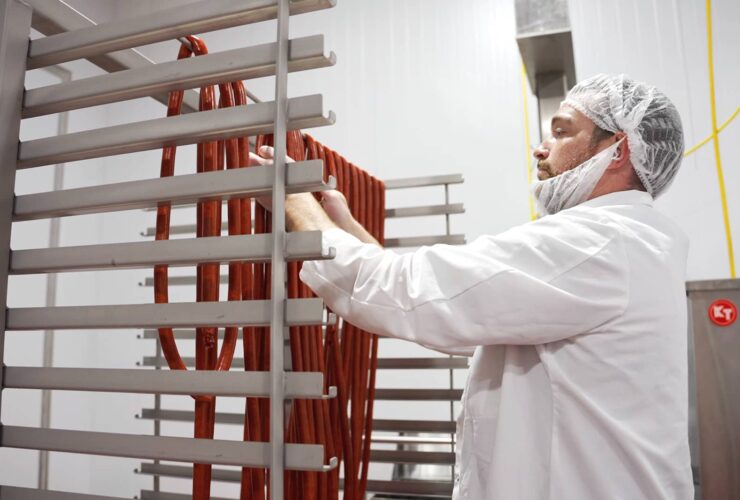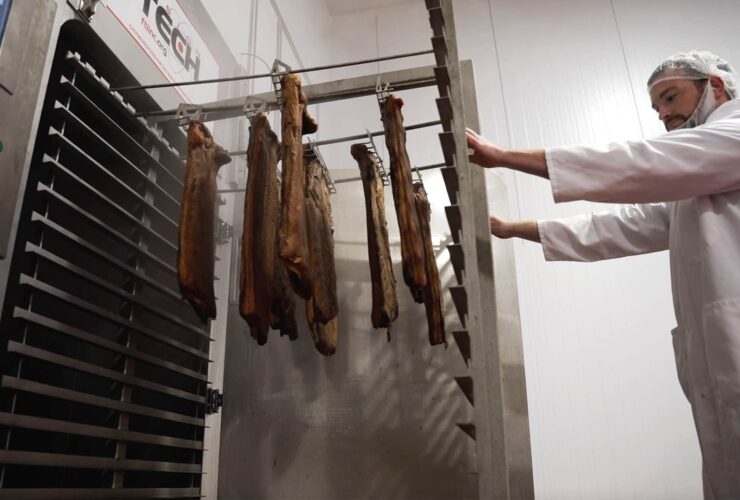Preparing your facility for a smokehouse installation is an essential step in purchasing an industrial oven.
Not only does proper preparation ensure a quick and easy installation of your new oven, but it also affects the life and operation of the oven.
Bumps in the flooring under the oven, lack of filters on water and air supplies, improper pressure on utilities, even the wrong floor slope can all wreak havoc on your oven, causing serious structural and operational problems down the road — most of which will not be covered by a manufacturer’s warranty.
Smokehouse Installation Prep
When it comes to preparing your facility for a smokehouse installation, the best place to start is with the manufacturer’s recommendations. They know their ovens, and they know what the ovens need in order to operate efficiently and correctly for years to come.
The manufacturer should provide you with a checklist and specifications of what is needed prior to installation, but below is a general “rule of thumb” when it comes to preparing for a smokehouse installation.
Floor Preparation
Proper floor preparation is critical for a smokehouse installation — as any imperfection can lead to structural issues down the road.
When preparing your floor, make sure it is:
- Smooth
- Level
- Includes proper anchors or grillage (depending on manufacturer’s recommendations)
- The slope is 1° or less
Any bumps in concrete under the oven, an unlevel floor, or concrete that isn’t poured and strengthened correctly will cause problems with your oven.
Concrete that cracks or isn’t level will cause the oven to shift. While it may not be an immediate problem, over time this shift will lead to serious issues with the oven — damaging the structural integrity, causing doors not to seal correctly, and making the oven less efficient.
There’s also the food safety aspect to think about. Cracks in the concrete give bacteria a place to hide and grow, eventually contaminating your product and causing serious health concerns.
Exhaust Pipe Preparation
Smokehouses need to exhaust somewhere and require their own exhaust pipes to function properly.
When installing exhaust pipes, follow these tips:
- The induction angle into the chimney should measure 30° to 45°.
- Avoid a rectangular induction (90°) as it causes the backflow of the exhaust air.
- Chimney or flue should only be used for the oven. Trying to exhaust multiple units into the same chimney or flue can lead to serious issues.
- Do not make the diameter of the chimney less than the outlets on the oven. They should be the same or slightly larger to ensure drying and smoking steps are not affected.
Exhaust plays a critical role in the smoking and drying steps of the oven.
If the exhaust pipes are too small or angled incorrectly, smoke may not exhaust correctly, causing the product to be negatively affected as well as health concerns for employees in the facility.
Water Supply Preparation
It is vitally important for the correct functioning of any smokehouse, especially those that use steam, that absolutely clean water is supplied.
Water with too much sediment, calcification, or too high of a micron count can result in issues with water supply lines in the oven, causing nozzles to clog, water and steam to not flow fast enough, and affect product during cooking.
When installing the water supply, follow these tips:
- Install a water filter system on the supply line.
- Connect a water softening system if the water contains a large percentage of calcification.
- Flush any lines that have been temporarily shut down prior to attaching to the oven. They often carry dirt, lime, or rust particles you don’t want in your oven.
Understand, most manufacturer’s warranties do not cover repairs caused when dirty water is let into the water pipe system of the oven.
Utility Preparation
Depending on the style and size of the oven you purchase, utilities such as steam, gas, and, of course, electricity are needed to properly run the oven.
Requirements and proper installation of these utilities should be provided by the manufacturer, but a few tips to consider:
- Ensure all utilities meet local, state, and federal requirements.
- Hire a professional to install lines and proper regulators.
- Ensure enough lines are run to easily attach to the oven.
- Ensure the volume of supply headers is large enough to handle the required usage per oven.
- Think long term — it’s easier and more cost-effective to put in larger supply headers than to do it again down the road.
Communications Wiring Preparation
Most ovens now require CAT5, or other communication wiring, to ensure the control panel can properly communicate with the oven.
When installing communication wiring, follow these tips:
- Check with the manufacturer on the correct wiring needed for their oven.
- Run more wire than needed. This way if the location of the control panel changes during the project or installation, your facility is still ready.
- Ensure proper connectors are installed on the wiring.
- Keep communication wiring separated from voltage wiring to prevent interruptions.
I/O Conduit and Wiring
When installing a custom smokehouse, or a smokehouse where the control panel is not located on the side of the oven, it is important for the customer to ensure proper conduit and wiring are ran prior to installation.
When installing I/O conduit and wiring, follow these tips:
- Decide in advance where the control panel box will be located in the facility and communicate this to the manufacturer.
- Determine how much conduit and wiring is required to reach from the control panel location to the oven.
- Run more wire than you think is needed, to ensure enough is present during installation.
Follow the Checklist
The above tips will help you prepare your facility for a smokehouse installation.
As mentioned before, always check with the manufacturer and refer to any provided operator’s manuals to ensure all utilities, flooring, and exhaust pipes meet their specific recommendations.
In order to help you ensure your facility is ready, we created a downloadable Smokehouse Installation Check List.
This checklist will walk you through everything discussed in this article, as well as specifics that are required for various oven options (such as gas-powered ovens, smoke generators, and more).





